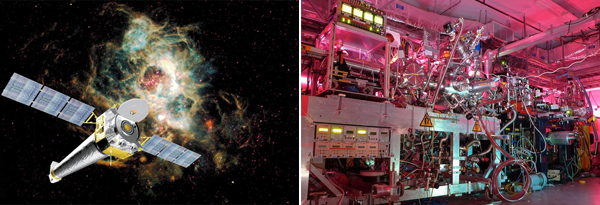Understanding What's Out There by Looking Down Here
As we've talked about before, science doesn't recognize boundaries. (In fact, we've created the Here, There, Everywhere project to explore this very idea.) Often, scientists need to do experiments here on Earth to better understand what's happening billions of miles away across the Universe.

Left: NASA's Chandra X-ray Observatory (Credit: NASA/MSFC/NGST); Right: instrument setup for an astrophysics experiment at SLAC's Linac Coherent Light Source (Photo by Jose R. Crespo Lopez-Urrutia, Max Planck Institute for Nuclear Physics)
A new press release issued by the SLAC National Accelerator Laboratory discusses some advances between the particle physics and astrophysics worlds. This release, which is based on a paper appearing in the latest issue of the journal Nature, is about an X-ray laser at their facility that is used to study how atoms behave in certain processes. Scientists then compare the results with those that telescopes like Chandra and XMM-Newton detect from distant objects like supernovas, black holes, and much more.
Without this correlation between observations from space, experiments on the ground, and theoretical and computer modeling, we simply don't have a good enough picture of how important phenomena work. It's exciting to see scientists from different disciplines of physics coming together to explore our Universe.
-Megan Watzke, CXC
Please note this is a moderated blog. No pornography, spam, profanity or discriminatory remarks are allowed. No personal attacks are allowed. Users should stay on topic to keep it relevant for the readers.
Read the privacy statement
